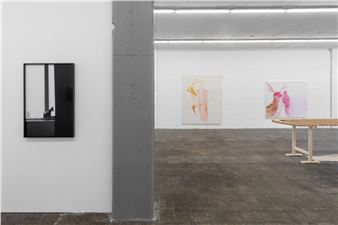What Is Interpreting Tradition?
The decision to link Gutman and the Bezalel art students was not arbitrary. Gutman was one of the first students in Boris SchatzÔÇÖs old Bezalel, and his art, and particularly that of the 1920s, is deeply rooted in the canon of Israeli art. The students were invited to scrutinize the early history of the institution in which they are studying and the beginnings of Israeli art, and respond from a contemporary personal, cultural and ideational perspective.
The studentsÔÇÖ focusing on Gutman and ÔÇ£what is interpreting traditionÔÇØ issue, engendered works in diverse media and topics, which brought Gutman into the contemporary art discourse: the artist-model relationship (Noam Wenkert; video), text and reconstructed and flawed biography (Tom Porat; video), remains of the ghosts of the past (Itamar Shimshony; video), feministic appropriation of masculine representation (Eden Ofrat Averbach; video) personification the concept of the archive (Yariv Spivak; photography, video), photographic reconstruction of erotic drawings (Shelly Alexander; photography), interfering with identity and intentional mistaken interpretation (Avi Milgrom; sound work), unifying times and biographies (Moshe Gershon; painting), critical reconstruction of self criticism (Yael Frank and Ori Levin; installation, photography), the image of the other in Israeli reality (Yulia Rabsky; painting), manipulation of humor, (Ori Levin; video), ridiculing national-Zionist sentiment (Zamir Shatz; painting), methods of distribution and duplication (Nir Segal; vinyl stickers), and even a Gutmanesque response to the tent protest (Keren Ella Gefen; painting).
For a defined period this group of Bezalel students became an interpretive community that examined how seemingly fixed meanings, which had become deeply rooted regarding GutmanÔÇÖs works, shifted, and moved from their place, losing their stability and holding, taking on new shapes, content, interpretation and context.
The wording of "what is interpreting tradition" alludes to a skeptical stance regarding the act of interpretation and its objects, thus creating a secondary question about the concepts of interpretation and tradition, and the praxis that coordinates their action. These questions and many others were addressed in the seminars that were part of the project. The ideas voiced during these seminars either permeated - both directly and indirectly - or did not permeate the exhibited works. Ultimately the participants were free to choose which new materials they wanted introduce into the studio, and how these would affect the ways of responding, interpreting, and understanding GutmanÔÇÖs works. The numerous proposals that appear in the exhibit enrich the reading of Gutman, and attest to the forceful presence of the creative persona in an inter-generational encounter, as well.
The decision to link Gutman and the Bezalel art students was not arbitrary. Gutman was one of the first students in Boris SchatzÔÇÖs old Bezalel, and his art, and particularly that of the 1920s, is deeply rooted in the canon of Israeli art. The students were invited to scrutinize the early history of the institution in which they are studying and the beginnings of Israeli art, and respond from a contemporary personal, cultural and ideational perspective.
The studentsÔÇÖ focusing on Gutman and ÔÇ£what is interpreting traditionÔÇØ issue, engendered works in diverse media and topics, which brought Gutman into the contemporary art discourse: the artist-model relationship (Noam Wenkert; video), text and reconstructed and flawed biography (Tom Porat; video), remains of the ghosts of the past (Itamar Shimshony; video), feministic appropriation of masculine representation (Eden Ofrat Averbach; video) personification the concept of the archive (Yariv Spivak; photography, video), photographic reconstruction of erotic drawings (Shelly Alexander; photography), interfering with identity and intentional mistaken interpretation (Avi Milgrom; sound work), unifying times and biographies (Moshe Gershon; painting), critical reconstruction of self criticism (Yael Frank and Ori Levin; installation, photography), the image of the other in Israeli reality (Yulia Rabsky; painting), manipulation of humor, (Ori Levin; video), ridiculing national-Zionist sentiment (Zamir Shatz; painting), methods of distribution and duplication (Nir Segal; vinyl stickers), and even a Gutmanesque response to the tent protest (Keren Ella Gefen; painting).
For a defined period this group of Bezalel students became an interpretive community that examined how seemingly fixed meanings, which had become deeply rooted regarding GutmanÔÇÖs works, shifted, and moved from their place, losing their stability and holding, taking on new shapes, content, interpretation and context.
The wording of "what is interpreting tradition" alludes to a skeptical stance regarding the act of interpretation and its objects, thus creating a secondary question about the concepts of interpretation and tradition, and the praxis that coordinates their action. These questions and many others were addressed in the seminars that were part of the project. The ideas voiced during these seminars either permeated - both directly and indirectly - or did not permeate the exhibited works. Ultimately the participants were free to choose which new materials they wanted introduce into the studio, and how these would affect the ways of responding, interpreting, and understanding GutmanÔÇÖs works. The numerous proposals that appear in the exhibit enrich the reading of Gutman, and attest to the forceful presence of the creative persona in an inter-generational encounter, as well.











